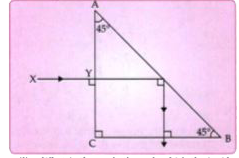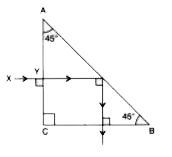A ray of light XY passes through a right angled isosceles prism as shown alongside.
Which prism surface will behave as a mirror ?
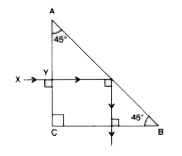
The surface AB of the prism behaves as the mirror.
Topper's Solved these Questions
- QUESTION PAPER-2018 Book:ICSEChapter:QUESTION PAPER-2018 Exercise:SECTION-II
Explore 42 Videos
- QUESTION PAPER 2022 TERM 1Book:ICSEChapter:QUESTION PAPER 2022 TERM 1Exercise:MULTIPLE CHOICE QUESTIONS
Explore 40 Videos
- QUESTION PAPER-2019Book:ICSEChapter:QUESTION PAPER-2019Exercise:SECTION-II
Explore 42 Videos
Similar Questions
Knowledge Check
A total reflecting right angled isosceles prism can be used to deviate a ray of light through :
A30∘B60∘C75∘D90∘In refraction of light through a prism the light ray:
Asuffers refraction only at one face of the prismBemergest out from the prism in a direction parallel to the incident rayCbends at both the surface of the prism towards its baseDbends at both the surfaces of the prism opposite to its base.
A ray of light XY passes through a right angled isosceles prism as shown alongside.
What is the angle through which the incident ray deviates and emerges out of the prism ?
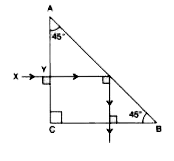
View Solution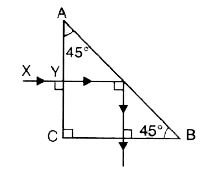
A ray of light XY passes through a right angled isosceles prism as shown alongside Figure.
(a) What is the angle through which the incident ray deviates and emerges out of the prism?
9b) Name the instrument where this action of prism is put into use.
(c) Which prism surface will behave as a mirror ?
View SolutionA ray of light XY passes through a right angled isosceles prism as shown below.
Name the instrument where this action of prism is put into use.
View SolutionA ray of light XY passes through a right angled isosceles prism as shown below.
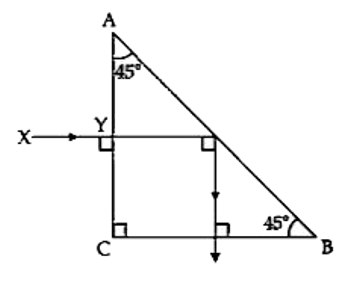
What is the angle through which the incident ray deviates and emerges out of the prism?
View SolutionA ray of light passes through the equilateral prism such that angle of incidence is equal to the angle of emergence if the angle of incidence is 45∘. The angle of deviation will be
View SolutionShow with the aid of a ray diagram, how a right angled isosceles prism can be used to invert the rays. (a) How sould the rays fall on the prism ?
(b) Which phenomenon is responsible for this action of prism? (c) What is the nature of the image in relation to the object ?
View Solution
